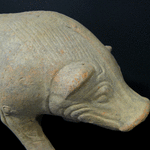Han Terracotta Boar, 206 BCE - 220 CE
Terracotta
18 x 10.5
TF.026
Further images
This magnificent terracotta boar dates to the Han era, the golden age of ceramic funerary sculpture. The fashion for terracotta grave goods, also known as mingqi, was undoubtedly stimulated by...
This magnificent terracotta boar dates to the Han era, the golden age of ceramic funerary sculpture. The fashion for terracotta grave goods, also known as mingqi, was undoubtedly stimulated by the example of the first emperor of the Qin Dynasty whose terracotta army is now legendary. Terracotta replicas of attendants, entertainers and domesticated animals were among the items interred to ensure the material comfort of the deceased in the afterlife. This practice continued to flourish until the fall of the Tang dynasty in the early tenth century, after which it became more common to burn the items intended to accompany the deceased.
This example is full of character; the boar stands with his head lowered and his front legs slightly apart. The body is compact and the stance is defensive, as if anticipating an imminent attack. Incised lines indicate the joints and the thick bristles on the animal’s back. The facial details are particularly impressive, especially the short protruding ears and the wide upturned snout. In many ancient cultures the boar was associated with strength, courage and fearless aggression. In China he also represented wealth and good fortune. Clearly well-nourished, this magnificent beast reflects the high status of its original owner. The time and skill that went into the manufacture of grave goods is extraordinary given the fact they were destined for obscurity in the ground. The impressive naturalism, especially in the depiction of animals, reflects Chinese religious beliefs. The more life-like the sculpture, the more likely it would perform its correct function in the afterworld. Our knowledge of the social and religious lives of Han has been vastly enriched by such finds which continue to impress us today. (AM)
This example is full of character; the boar stands with his head lowered and his front legs slightly apart. The body is compact and the stance is defensive, as if anticipating an imminent attack. Incised lines indicate the joints and the thick bristles on the animal’s back. The facial details are particularly impressive, especially the short protruding ears and the wide upturned snout. In many ancient cultures the boar was associated with strength, courage and fearless aggression. In China he also represented wealth and good fortune. Clearly well-nourished, this magnificent beast reflects the high status of its original owner. The time and skill that went into the manufacture of grave goods is extraordinary given the fact they were destined for obscurity in the ground. The impressive naturalism, especially in the depiction of animals, reflects Chinese religious beliefs. The more life-like the sculpture, the more likely it would perform its correct function in the afterworld. Our knowledge of the social and religious lives of Han has been vastly enriched by such finds which continue to impress us today. (AM)





